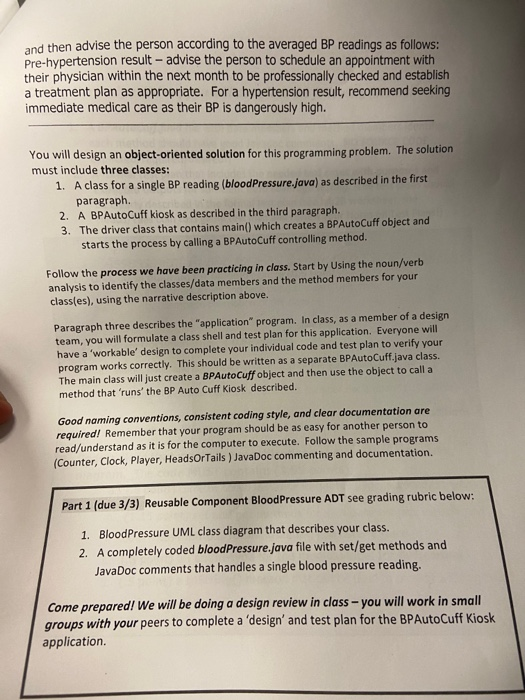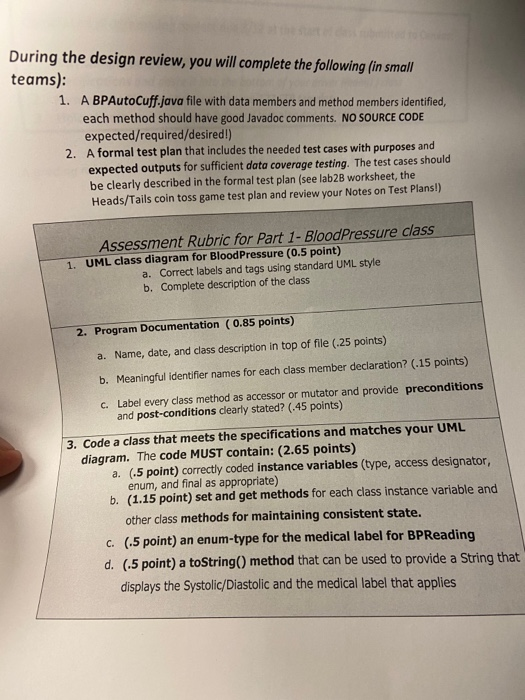please write in Java (Netbeans)
CSC-122 Computer Science ! 7.5 points Project #2 -- Blood Pressure Readings This project promotes the following Student Learning Outcomes: Identify objects associated with a stated problem, then design, code, and test a set of classes for their representation that demonstrates encapsulation, data abstraction, and information hiding. Organize programs based on separate definition, and application files that demonstrate security considerations. Develop applications based on code designed for reuse and extensibility using best practice software engineering techniques. Student Preparation Checklist - do the following before starting this assignment: Have completed assigned readings for chapters 1-3, 5.1-5.4 Reviewed the Notes on Test Plans Reviewed class programming projects Part 1. A single blood pressure reading consists of two measurements: the systolic pressure and the diastolic pressure. Blood pressure is reported as "systolic over diastolic" (e.g. 110 over 72) and is written as systolic diastolic (e.g. 110/72) If either the systolic is 120 - 139 or the diastolic measure is 80 - 89, the blood pressure is considered to be pre-hypertension and needs to be closely monitored. Blood pressure measurements with systolic 140 or higher or diastolic 90 or higher are labeled as hypertension and is considered dangerously high and requires medical attention. Blood pressure below the pre-hypertension measurements are considered normalBP (e.g. 110/72 is normal) Part 2. Create a Java OOP program that simulates a BPCuff Kiosk that you frequently see in pharmacies. It can be used to assist screening people for normal, pre-hypertension, or hypertension (aka high BP) by doing the following: Welcome the person to the CCC BP Cuff kiosk. The instructions should tell the person to " Relax and then put their arm into the sleeve. Press the button when ready to begin the test." Simulate and report a Systolic/Diastolic reading with its appropriate label (normal, pre-hypertension, hypertension). For a normal reading, the program should advise the person to get checked again in a year. For a pre-hypertension or hypertension reading, the program should repeat ask the person to repeat the test, compute the integer) average of the two readings and then advise the person according to the averaged BP readings as follows: Pre-hypertension result - advise the person to schedule an appointment with their physician within the next month to be professionally checked and establish a treatment plan as appropriate. For a hypertension result, recommend seeking immediate medical care as their BP is dangerously high. You will design an object-oriented solution for this programming problem. The solution must include three classes: 1. A class for a single BP reading (blood Pressure.java) as described in the first paragraph. 2. ABPAutoCuff kiosk as described in the third paragraph. 3. The driver class that contains main() which creates a BPAutoCuff object and starts the process by calling a BPAutoCuff controlling method. Follow the process we have been practicing in class. Start by Using the noun/verb analysis to identify the classes/data members and the method members for your class(es), using the narrative description above. Paragraph three describes the "application program. In class, as a member of a design team, you will formulate a class shell and test plan for this application. Everyone will have a 'workable' design to complete your individual code and test plan to verify your program works correctly. This should be written as a separate BPAutoCuff.java class, The main class will just create a BPAutoCuff object and then use the object to call a method that 'runs' the BP Auto Cuff Kiosk described. Good naming conventions, consistent coding style, and clear documentation are required! Remember that your program should be as easy for another person to read/understand as it is for the computer to execute. Follow the sample programs (Counter, Clock, Player, HeadsOrTails ) JavaDoc commenting and documentation. Part 1 (due 3/3) Reusable Component Blood Pressure ADT see grading rubric below: 1. Blood Pressure UML class diagram that describes your class. 2. A completely coded blood Pressure.java file with set/get methods and JavaDoc comments that handles a single blood pressure reading. Come prepared! We will be doing a design review in class - you will work in small groups with your peers to complete a 'design' and test plan for the BPAutoCuff Kiosk application. During the design review, you will complete the following (in small teams): 1. A BPAutoCuff.Java file with data members and method members identified, each method should have good Javadoc comments. NO SOURCE CODE expected/required/desired!) 2. A formal test plan that includes the needed test cases with purposes and expected outputs for sufficient data coverage testing. The test cases should be clearly described in the formal test plan (see lab2B worksheet, the Heads/Tails coin toss game test plan and review your Notes on Test Plansl) Assessment Rubric for Part 1 - BloodPressure class 1. UML class diagram for Blood Pressure (0.5 point) a. Correct labels and tags using standard UML style b. Complete description of the class 2. Program Documentation (0.85 points) a. Name, date, and class description in top of file (.25 points) b. Meaningful identifier names for each class member declaration? (.15 points) c. Label every class method as accessor or mutator and provide preconditions and post-conditions clearly stated? (.45 points) 3. Code a class that meets the specifications and matches your UML diagram. The code MUST contain: (2.65 points) a. (.5 point) correctly coded instance variables (type, access designator, enum, and final as appropriate) b. (1.15 point) set and get methods for each class instance variable and other class methods for maintaining consistent state. C. (.5 point) an enum-type for the medical label for BPReading d. (.5 point) a toString() method that can be used to provide a String that displays the Systolic/Diastolic and the medical label that applies CSC-122 Computer Science ! 7.5 points Project #2 -- Blood Pressure Readings This project promotes the following Student Learning Outcomes: Identify objects associated with a stated problem, then design, code, and test a set of classes for their representation that demonstrates encapsulation, data abstraction, and information hiding. Organize programs based on separate definition, and application files that demonstrate security considerations. Develop applications based on code designed for reuse and extensibility using best practice software engineering techniques. Student Preparation Checklist - do the following before starting this assignment: Have completed assigned readings for chapters 1-3, 5.1-5.4 Reviewed the Notes on Test Plans Reviewed class programming projects Part 1. A single blood pressure reading consists of two measurements: the systolic pressure and the diastolic pressure. Blood pressure is reported as "systolic over diastolic" (e.g. 110 over 72) and is written as systolic diastolic (e.g. 110/72) If either the systolic is 120 - 139 or the diastolic measure is 80 - 89, the blood pressure is considered to be pre-hypertension and needs to be closely monitored. Blood pressure measurements with systolic 140 or higher or diastolic 90 or higher are labeled as hypertension and is considered dangerously high and requires medical attention. Blood pressure below the pre-hypertension measurements are considered normalBP (e.g. 110/72 is normal) Part 2. Create a Java OOP program that simulates a BPCuff Kiosk that you frequently see in pharmacies. It can be used to assist screening people for normal, pre-hypertension, or hypertension (aka high BP) by doing the following: Welcome the person to the CCC BP Cuff kiosk. The instructions should tell the person to " Relax and then put their arm into the sleeve. Press the button when ready to begin the test." Simulate and report a Systolic/Diastolic reading with its appropriate label (normal, pre-hypertension, hypertension). For a normal reading, the program should advise the person to get checked again in a year. For a pre-hypertension or hypertension reading, the program should repeat ask the person to repeat the test, compute the integer) average of the two readings and then advise the person according to the averaged BP readings as follows: Pre-hypertension result - advise the person to schedule an appointment with their physician within the next month to be professionally checked and establish a treatment plan as appropriate. For a hypertension result, recommend seeking immediate medical care as their BP is dangerously high. You will design an object-oriented solution for this programming problem. The solution must include three classes: 1. A class for a single BP reading (blood Pressure.java) as described in the first paragraph. 2. ABPAutoCuff kiosk as described in the third paragraph. 3. The driver class that contains main() which creates a BPAutoCuff object and starts the process by calling a BPAutoCuff controlling method. Follow the process we have been practicing in class. Start by Using the noun/verb analysis to identify the classes/data members and the method members for your class(es), using the narrative description above. Paragraph three describes the "application program. In class, as a member of a design team, you will formulate a class shell and test plan for this application. Everyone will have a 'workable' design to complete your individual code and test plan to verify your program works correctly. This should be written as a separate BPAutoCuff.java class, The main class will just create a BPAutoCuff object and then use the object to call a method that 'runs' the BP Auto Cuff Kiosk described. Good naming conventions, consistent coding style, and clear documentation are required! Remember that your program should be as easy for another person to read/understand as it is for the computer to execute. Follow the sample programs (Counter, Clock, Player, HeadsOrTails ) JavaDoc commenting and documentation. Part 1 (due 3/3) Reusable Component Blood Pressure ADT see grading rubric below: 1. Blood Pressure UML class diagram that describes your class. 2. A completely coded blood Pressure.java file with set/get methods and JavaDoc comments that handles a single blood pressure reading. Come prepared! We will be doing a design review in class - you will work in small groups with your peers to complete a 'design' and test plan for the BPAutoCuff Kiosk application. During the design review, you will complete the following (in small teams): 1. A BPAutoCuff.Java file with data members and method members identified, each method should have good Javadoc comments. NO SOURCE CODE expected/required/desired!) 2. A formal test plan that includes the needed test cases with purposes and expected outputs for sufficient data coverage testing. The test cases should be clearly described in the formal test plan (see lab2B worksheet, the Heads/Tails coin toss game test plan and review your Notes on Test Plansl) Assessment Rubric for Part 1 - BloodPressure class 1. UML class diagram for Blood Pressure (0.5 point) a. Correct labels and tags using standard UML style b. Complete description of the class 2. Program Documentation (0.85 points) a. Name, date, and class description in top of file (.25 points) b. Meaningful identifier names for each class member declaration? (.15 points) c. Label every class method as accessor or mutator and provide preconditions and post-conditions clearly stated? (.45 points) 3. Code a class that meets the specifications and matches your UML diagram. The code MUST contain: (2.65 points) a. (.5 point) correctly coded instance variables (type, access designator, enum, and final as appropriate) b. (1.15 point) set and get methods for each class instance variable and other class methods for maintaining consistent state. C. (.5 point) an enum-type for the medical label for BPReading d. (.5 point) a toString() method that can be used to provide a String that displays the Systolic/Diastolic and the medical label that applies









